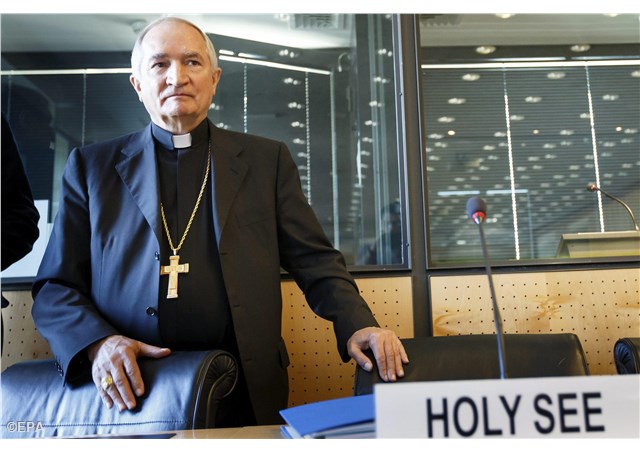
AB Tomasi calls for concerted efforts to stamp out slavery

(Vatican Radio) The Holy See’s representative to the United Nations in Geneva, Archbishop Silavano Tomasi, has called for greater international efforts to eliminate forced labour, human trafficking and other forms of slavery or exploitation. Archbishop Tomasi was speaking on Tuesday during the 30th session of the UN’s Human Rights Council, currently taking place in Geneva.
Responding to a report from the Special Rapporteur on contemporary forms of slavery, the Vatican delegate said national and international efforts should be “committed to prevention, to victim protection, to the legal prosecution of perpetrators, working for victims' psychological and educational rehabilitation”.
Calling for countries to overcome the “globalization of indifference”, Archbishop Tomasi said “States should ensure that their own legislation truly respects the dignity of the human person in the areas of migration, employment, adoption, the movement of businesses offshore and the sale of items produced by slave labor”.
Please find below the full statement by Archbishop Silvano Tomasi
Statement on Contemporary Forms of Slavery by H.E. Archbishop Silvano M. Tomasi, Permanent Representative of the Holy See to the United Nations and Other International Organizations in Geneva at the 30th Session of the Human Rights Council
Geneva, 15 September 2015
Mr. President,
My Delegation thanks the Special Rapporteur for her thought-provoking Report on contemporary forms of slavery, including its causes and consequences.
At the present time, 35.8 million people experience the deprivation of one of the fundamental and universal rights: the right to be free from slavery in all its numerous forms. According to ILO data, 5.5 million of the 20.9 million persons in forced labor are children with up to 15 per cent of those working in supply chains.
As the Special Rapporteur underlines, even if globalization has created unprecedented opportunities, “the demand for cheap labor meets a ready supply of workers from vulnerable groups: indigenous people, minorities, those considered to be from the “lowest castes” and migrants, especially those in an irregular situation.”
Sectors with a high risk of contemporary forms of slavery using supply chains, include agriculture, construction, mining and the textile industry. These often “rely on temporary or migrant labor and are characterized by complex contracting and subcontracting chains which make the victims dependent on their exploiters,” especially “in countries where labor regulations fail to comply with international norms and minimum standards, or, equally illegally, in countries which lack legal protection for workers’ rights.”
Such enslavement is accomplished by blackmail and threats made against workers and their loved ones, by the confiscation of their identity documents, through physical violence, and by forcing them to live clandestinely or in disgraceful living and working conditions.
However, there are many other forms of slavery which go beyond the exploitation of forced labor of the supply chain: a great number of people, many of whom are minors, are also forced into prostitution, or to become sex slaves. Women are forced into marriage or sold for arranged marriages and bequeathed to relatives of their deceased husbands without any right to give or withhold their consent. There are also persons, minors and adults alike, who are made objects of trafficking for the sale of organs, for recruitment as soldiers, for begging, for illegal activities such as the production and sale of narcotics or for disguised forms of cross-border adoption.
This old inhuman phenomenon of man’s subjugation by man, is rooted, today as in the past, in “a notion of the human person which allows him or her to be treated as an object, deprived of their freedom, sold and reduced to being the property of others and treated as a means to an end.”
Frequently, the victims of human trafficking and slavery are taken in by false promises of employment, while looking for a way out of a situation of extreme poverty or they are forced by debt bondage. However, beyond poverty, many other causes help to explain contemporary forms of slavery. Among these, we can find underdevelopment and exclusion, and also corruption, greed, armed conflicts, violence, criminal activity and terrorism.
The task of the International Community is to “recognize that we are facing a global phenomenon which exceeds the competence of any one community or country” and “in order to eliminate it, we need a mobilization comparable in size to that of the phenomenon itself.”
National and international efforts should be committed to prevention, to victim protection, to the legal prosecution of perpetrators, working for victims' psychological and educational rehabilitation in order to reintegrate them into the society where they live or from which they have come. States should ensure that their own legislation truly respects the dignity of the human person in the areas of migration, employment, adoption, the movement of businesses offshore and the sale of items produced by slave labor, seeking the most suitable modalities to punish those who are complicit in this inhuman trade. Intergovernmental Organizations, in keeping with the principle of subsidiarity, are called to coordinate initiatives for combating the transnational networks of organized crime which oversee the trafficking of persons and the illegal trafficking of migrants. In this regard, the many efforts of the Catholic Church, especially on the part of religious communities, to counter the modern form of slavery could be used as a best practice for other institutions and agencies.
Mr. President,
It is necessary for the International Community to cast off the relativistic culture where one person takes advantage of another, treating others as mere objects, imposing forced labor on them or enslaving them to pay their debts. We must overcome the “globalization of indifference” to their plight, transforming it through a renewed sense of solidarity and fraternity.
Thank you, Mr. President.
| All the contents on this site are copyrighted ©. |


